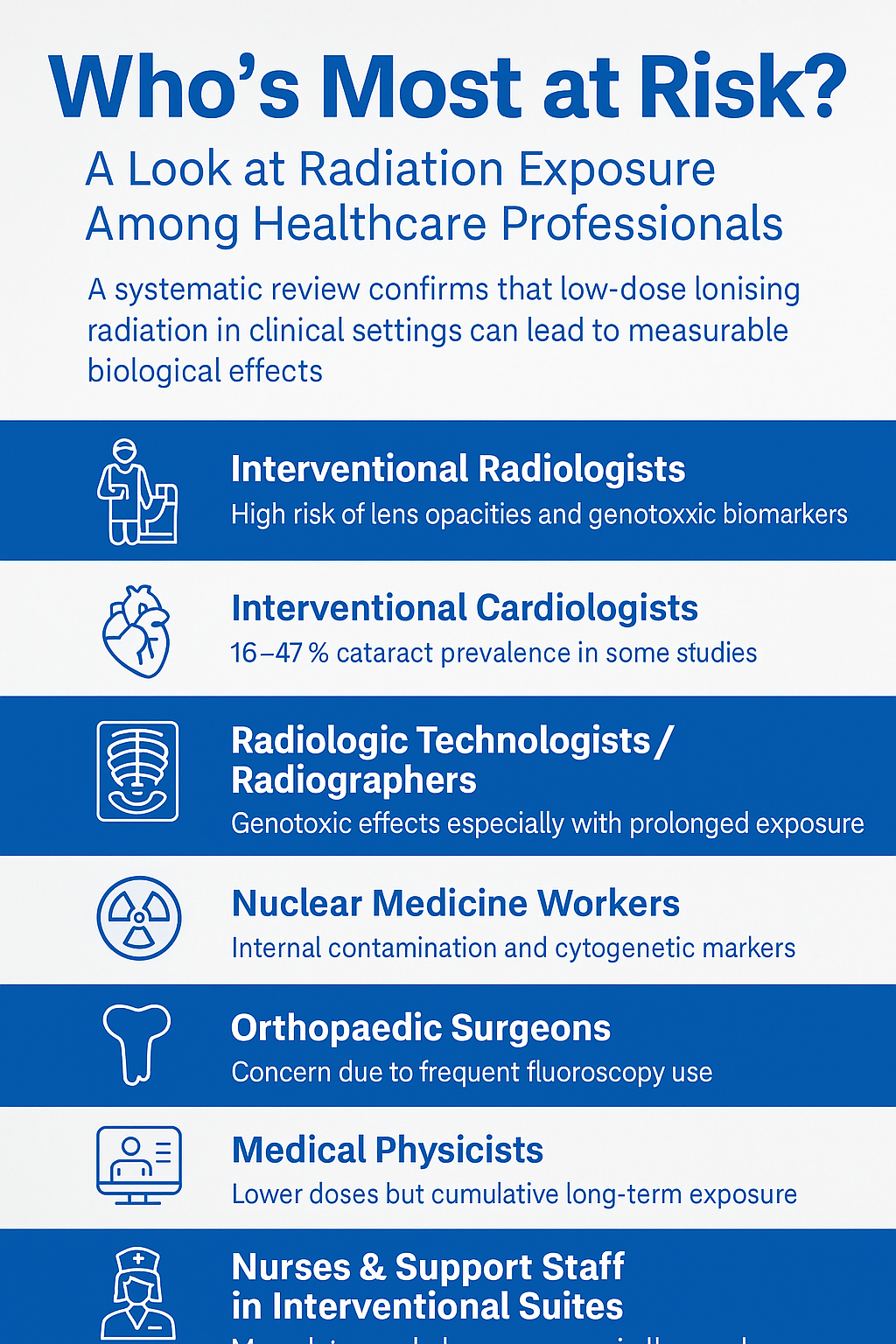Are Radiation Workers Still at Risk?
A recent paper by Lopes, Teles, and Santos, published in the Journal of Radiological Protection, reaffirms a sobering truth: healthcare professionals working with ionising radiation continue to face measurable occupational health risks, despite the safety protocols in place.
In their systematic review of 32 peer-reviewed studies (2019–2023), the authors dive into the biological effects of chronic low-dose exposure—shedding light on a range of measurable cellular changes and health consequences faced by radiographers, interventionalists, and other frontline imaging professionals.
What Did the Review Find?
The review focused on biomarkers of radiation damage, including:
Micronuclei (MN) frequency – a genetic indicator of DNA damage
Chromosomal Aberrations (CA) – known precursors to malignancy
Lens opacities and cataracts – once considered a deterministic effect, now linked to much lower doses
Key Findings:
Elevated MN and CA in exposed workers compared to control groups
16–47% of interventional professionals showed some form of lens opacity
Increased cancer risk was noted in certain subgroups, especially those with prolonged exposure or inadequate protective practices
Why This Matters
This review pulls together the most current scientific evidence and confirms what many in the radiation protection community already suspect: even low-dose, long-term exposure can leave a biological footprint.
For those of us advocating for tighter protection standards and regular monitoring, this paper strengthens the call for:
Routine biomarker surveillance
Enhanced eye protection, particularly in interventional settings
Stricter compliance with ALARA principles
The Strengths
Up-to-date and PRISMA-compliant: Only studies published in the last five years were included, giving us a clear snapshot of the current risk landscape.
Focus on biomarkers: These early indicators are critical for prevention—detecting problems before they become clinical.
Global relevance: Findings apply across healthcare systems, from high-resource environments to emerging markets.
Areas for Development
While the review is methodologically sound, it does leave some questions unanswered:
No meta-analysis: The lack of statistical pooling means we miss out on quantitative estimates of risk.
Limited detail on dosimetry: Information on actual dose levels, shielding practices, or time-at-risk is sparse.
No clear clinical guidance: More actionable outcomes would have strengthened the practical utility—especially for Radiation Protection Supervisors and health & safety officers.
Conclusion: A Timely Wake-Up Call
This paper is a timely reminder that we cannot afford complacency in radiation safety. Technological advances have improved imaging, but the risk to those behind the machines remains real and measurable. As the authors note, genetic instability and lens damage are not relics of the past—they are present-day occupational hazards.
If you are a healthcare manager, a radiation worker, or a policymaker, this is essential reading. It underscores the need for ongoing training, investment in PPE, and systematic health surveillance to protect those who protect others.In the modern healthcare environment, ionising radiation is an indispensable diagnostic and therapeutic tool. However, the increasing reliance on procedures such as fluoroscopy, CT imaging, and nuclear medicine has raised important concerns about the long-term health risks for healthcare professionals routinely exposed to low-dose radiation.
This paper by Lopes, Teles, and Santos (2025) presents a systematic review of the most recent literature (2019–2023) to evaluate the biological and clinical consequences of occupational exposure to ionising radiation in medical settings. Drawing on 32 peer-reviewed studies, the authors explore a range of outcomes, including genotoxic effects (micronuclei formation and chromosomal aberrations), increased prevalence of cataracts (particularly among interventional staff), and potential cancer risks.
The review is framed within the context of occupational radiation protection, highlighting not only the persistence of measurable biological effects in exposed workers, but also the need for enhanced surveillance, preventive strategies, and regulatory enforcement to protect healthcare personnel over the course of their careers.
Lopes, S., Teles, P. and Santos, L., 2025. A systematic review on the occupational health impacts of ionising radiation exposure among healthcare professionals. Journal of Radiological Protection, [online] 45(2), pp.1–18. Available at: https://doi.org/10.1088/1361-6498/added2 [Accessed 14 Jun. 2025].



